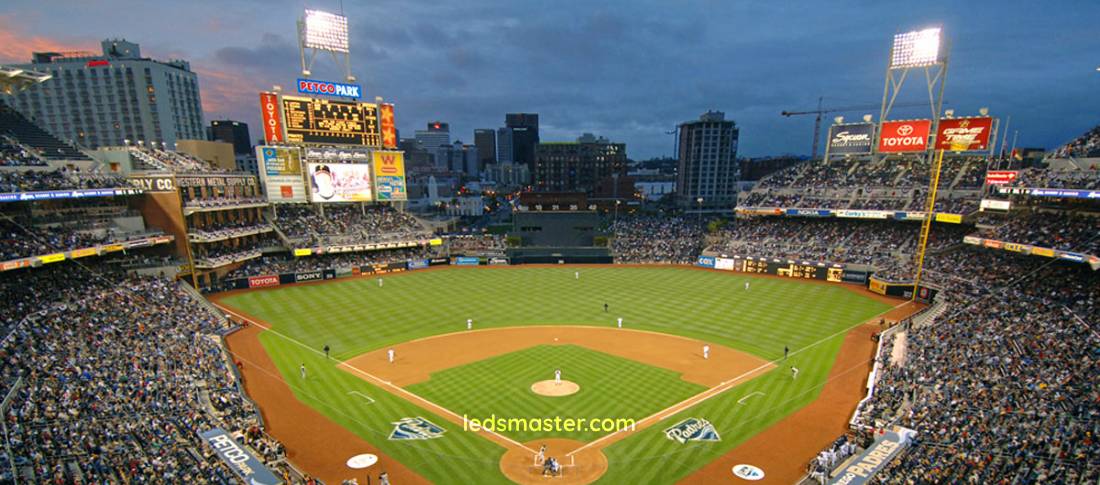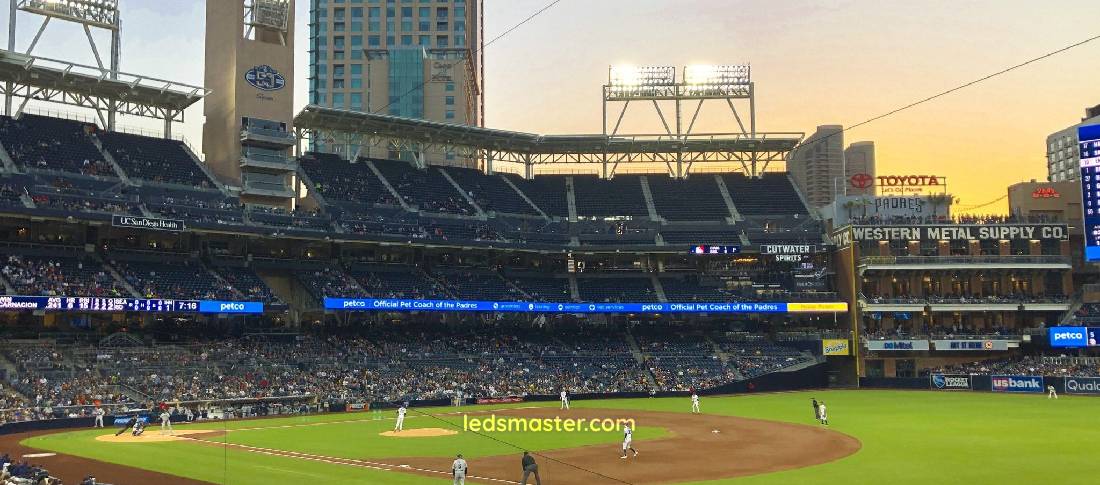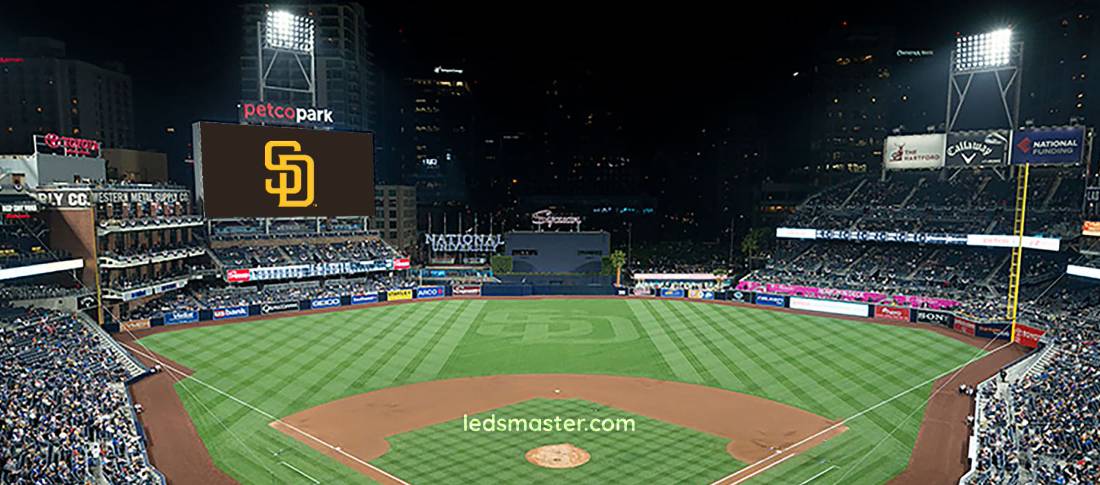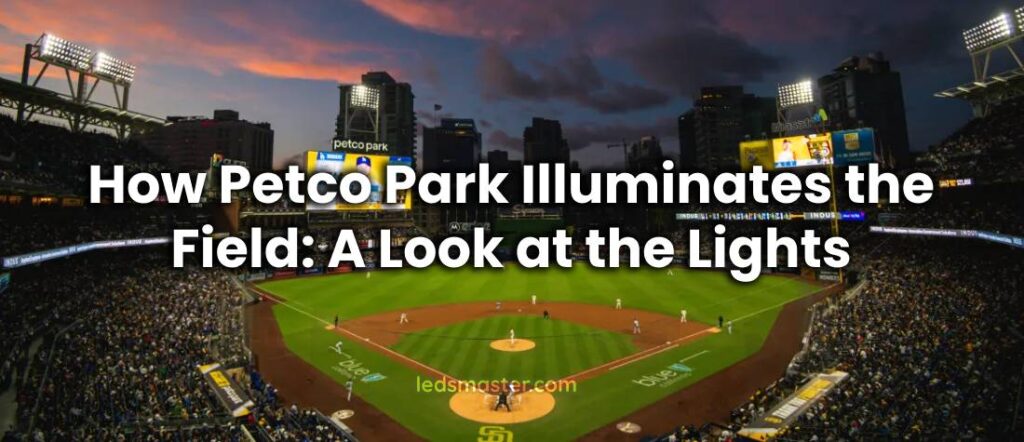Petco Park, the home of the San Diego Padres, is a state-of-the-art baseball stadium that has become a cornerstone of San Diego’s sports and entertainment landscape since its opening in 2004. Situated in the heart of downtown San Diego, Petco Park boasts a modern design that blends seamlessly with the city’s architecture while offering a fan-centric experience. Among the stadium’s many features, its lighting system plays a crucial role in ensuring that the field is illuminated to meet both operational and aesthetic standards. This article delves into the specifics of how Petco Park’s lighting is designed, implemented, and maintained to create a premier viewing experience.
Table of Contents
ToggleThe Lighting Design at Petco Park

The Role of Lighting in a Modern Stadium
Lighting is far more than just a functional requirement; it is integral to the overall spectator experience and operational efficiency. The lighting system in a modern stadium like Petco Park serves multiple critical roles, each essential for creating an optimal environment for both players and fans.
First and foremost, lighting enhances visibility on the field. For players and officials, this means clear, uninterrupted views that are crucial for performance and safety. Proper illumination ensures that players can see the ball, judge distances accurately, and navigate the field without impediment. For officials, consistent lighting helps in making precise decisions, which is vital for maintaining the flow and fairness of the game.
Beyond the practical aspects, lighting also contributes to the aesthetic appeal of the stadium. The visual ambiance created by the lighting enhances the fan experience, making games more enjoyable and memorable. During night games, for instance, a well-lit field creates a dramatic and immersive atmosphere that heightens the excitement of the event. Furthermore, the lighting design is crucial for broadcasting purposes. Televised games require high-quality lighting to capture the action clearly and vividly, ensuring that viewers at home have an optimal viewing experience.
For baseball, in particular, the lighting needs to adhere to specific standards to ensure that games can be played comfortably at any time of day. These standards include meeting the minimum lux levels required by Major League Baseball (MLB) and ensuring that the lighting system is capable of reducing shadows and glare, which could otherwise impact gameplay. The system must be versatile enough to accommodate various conditions, whether it’s a sunny afternoon or a twilight game, ensuring consistent performance throughout.
Lighting Layout and Fixtures
Petco Park’s lighting design is a sophisticated blend of high-intensity floodlights and advanced LED technology. This combination ensures that the stadium meets the demanding lighting requirements of a major league baseball park while also taking advantage of the latest advancements in lighting technology.
The layout of the lighting fixtures at Petco Park is meticulously planned to achieve uniform illumination across the field. Floodlights are mounted on tall poles positioned strategically around the stadium, providing broad and even coverage. These floodlights are designed to project light over a wide area, reducing shadows and preventing dark spots that could affect gameplay. The precise positioning of these lights is crucial; they must be placed at angles that ensure the field is lit evenly, without creating excessive glare or obstructing players’ views.
In addition to traditional floodlights, Petco Park utilizes LED technology, which offers several advantages over older lighting methods. LEDs are known for their energy efficiency, long lifespan, and ability to produce high-quality light with minimal heat emission. This makes them particularly suitable for a stadium environment, where maintaining optimal lighting conditions while managing energy costs is a key concern.
The LED fixtures at Petco Park are designed to complement the floodlights, providing additional illumination where needed and enhancing the overall lighting quality. These fixtures are often mounted in conjunction with floodlights to ensure that every corner of the field is adequately lit. The integration of LEDs also allows for greater flexibility in controlling light intensity and color temperature, which can be adjusted to suit different types of events and create various visual effects.
The careful design and placement of these lighting fixtures ensure that Petco Park meets the high standards required for major league games while providing a visually appealing environment for fans. The combination of high-intensity floodlights and advanced LED technology results in a lighting system that not only meets operational requirements but also enhances the overall game experience.

Number of Lights Needed
Calculating the Requirements
The determination of the number of lights required for a stadium like Petco Park involves a complex and precise calculation, influenced by multiple factors that ensure the field is lit according to professional standards. The primary consideration is the level of illumination, measured in lux, which is essential for meeting the requirements set by Major League Baseball (MLB). For MLB games, the standard mandates a minimum of 1,000 lux across the playing field to ensure optimal visibility for players, officials, and spectators.
To calculate the number of lights needed, engineers start by conducting detailed simulations and modeling of the stadium’s lighting setup. This process involves analyzing the size and layout of the field, the height and type of lighting fixtures, and the desired level of illumination. The goal is to design a lighting system that not only meets but exceeds the 1,000 lux requirement, providing uniform light coverage across the entire field. This uniformity is crucial for preventing uneven lighting, which could lead to shadows and glare that might affect gameplay.
The calculation process also takes into account the specific lighting needs of baseball games. Baseball fields require a unique lighting configuration due to the nature of the sport, which involves tracking a fast-moving ball and ensuring that players and umpires can see clearly from all positions on the field. To achieve this, the lighting system must be designed to eliminate shadows and provide consistent brightness from all angles.
For a stadium the size of Petco Park, which covers a large playing area and accommodates thousands of spectators, the lighting system typically involves the installation of hundreds of high-intensity floodlights. These floodlights are selected based on their ability to deliver high levels of illumination while minimizing heat and energy consumption. The number and type of fixtures are determined through precise calculations that account for factors such as light distribution, fixture efficiency, and the overall design of the stadium.
Optimal Placement
Once the number of lights has been determined, the next critical step is the optimal placement of these fixtures to ensure effective and even coverage of the field. Proper placement is vital to avoid creating shadows that could impede gameplay or distract players and spectators. At Petco Park, this involves installing lights on towering poles that are strategically positioned around the stadium.
The height and location of these poles are carefully planned to provide comprehensive coverage of the field. Typically, light poles are positioned at key points around the stadium, such as the corners and sides, to ensure that light is projected evenly across the entire playing area. The height of the poles allows the floodlights to cast light over a wide area, reducing the potential for shadows and ensuring that every part of the field is well-lit.
In addition to height and placement, the angles at which the lights are set are also crucial. The fixtures are angled to direct light precisely where it is needed, avoiding direct glare that could affect players’ vision. The goal is to create a lighting environment where every area of the field is illuminated consistently, enhancing visibility and performance while providing a visually appealing experience for fans.
The strategic placement of lights at Petco Park not only supports the practical needs of the game but also contributes to the overall aesthetic of the stadium. Well-placed lighting enhances the visual appeal of the stadium, making night games more vibrant and engaging for spectators. By carefully balancing the number and placement of lights, Petco Park ensures that it meets the highest standards of illumination for major league baseball games, providing a top-tier experience for both players and fans.

Optimal Height for Light Poles
The Importance of Height
The height of the light poles at Petco Park is a fundamental element in the stadium’s lighting design, crucial for achieving optimal illumination across the field. The correct height ensures that light is distributed evenly and effectively, which is essential for providing a high-quality experience for players, officials, and spectators.
For a stadium like Petco Park, light poles are typically set at heights ranging from 80 to 100 feet. This range is selected based on a combination of factors, including the size of the field, the type of lighting fixtures used, and the need to minimize shadows. The height of the poles allows the fixtures to cover the entire field area comprehensively, ensuring that light is projected uniformly across the playing surface.
One of the key considerations in determining the height of the light poles is the need to avoid creating excessive shadows. Shadows on the field can interfere with gameplay, making it difficult for players to track the ball and execute plays effectively. By positioning the poles at an appropriate height, the lighting system can achieve a level of illumination that minimizes shadows and provides clear visibility from all angles.
Additionally, the height of the poles is crucial for achieving proper light dispersion. At Petco Park, the lighting design aims to distribute light evenly across the field, which helps to maintain uniformity and avoid areas of overexposure or darkness. Proper light dispersion is essential for reducing glare, which can be a significant distraction for both players and spectators. By ensuring that light is spread evenly and without excessive intensity, the lighting system enhances the overall visibility and comfort of the viewing experience.
Balancing Visibility and Aesthetics
While the primary objective of the lighting system is to provide adequate illumination for gameplay, the height of the light poles also plays an important role in the overall aesthetics of Petco Park. The design of the lighting infrastructure must balance functional requirements with the visual appeal of the stadium.
Incorporating the light poles into the stadium’s architecture requires careful consideration of their impact on the surrounding environment. The height and placement of the poles are designed to ensure that they do not obstruct the view of the skyline or interfere with the visual aesthetics of the park. This integration is achieved by positioning the poles in such a way that they complement the stadium’s design rather than detract from it.
The design process also takes into account the visual experience of the spectators. Light poles that are too tall or poorly positioned could obstruct sightlines or create visual clutter, detracting from the enjoyment of the game. By ensuring that the poles are aesthetically pleasing and harmoniously integrated into the stadium’s design, Petco Park enhances the overall fan experience.
The balance between functionality and aesthetics is achieved through a thoughtful design approach that considers both the practical requirements of lighting and the visual impact of the infrastructure. This approach ensures that the lighting system at Petco Park not only meets the technical standards required for major league baseball but also contributes to the stadium’s overall ambiance and appeal.
Lighting Standards at Petco Park
Meeting MLB Requirements
Petco Park’s lighting system is meticulously designed to adhere to the stringent standards set by Major League Baseball (MLB). These standards are crucial for ensuring that games are played under optimal lighting conditions, regardless of whether the game is held during the day or night. The primary requirements include achieving specific lux levels and maintaining uniformity across the field.
For MLB games, the minimum illumination requirement is set at 1,000 lux. This level of brightness ensures that players, umpires, and spectators can clearly see the ball and the action on the field. Petco Park’s lighting system is engineered not only to meet this minimum requirement but to exceed it, providing enhanced visibility and a superior viewing experience. Achieving higher lux levels than the minimum standard contributes to reducing shadows and glare, which is essential for maintaining the quality of play and the overall enjoyment of the game.
Uniformity in lighting is another critical aspect of MLB standards. The lighting design at Petco Park is carefully planned to ensure that the field is evenly illuminated, without areas of overexposure or darkness. This uniformity helps to prevent any potential distractions or visibility issues during play, allowing players to perform at their best and ensuring that spectators have an uninterrupted view of the action.
The lighting fixtures are strategically placed and calibrated to achieve the desired lux levels and uniformity. This involves detailed simulations and modeling to ensure that every part of the field receives adequate and consistent illumination. By adhering to these standards, Petco Park ensures that it provides a high-quality lighting environment that enhances the overall game experience.
Compliance with Industry Standards
In addition to meeting MLB requirements, Petco Park’s lighting system also complies with broader industry standards related to energy efficiency and environmental impact. This compliance reflects the stadium’s commitment to sustainability and responsible energy use.
A key element in meeting these standards is the use of LED technology. LEDs are known for their energy efficiency, consuming significantly less power compared to traditional lighting options such as metal halide lamps. This reduction in energy consumption not only helps to lower operational costs but also aligns with environmental goals by reducing the stadium’s overall carbon footprint.
The longevity of LED lights is another factor that contributes to Petco Park’s sustainability efforts. LEDs have a longer operational life compared to conventional lighting sources, which means fewer replacements and less waste. This durability reduces maintenance requirements and the environmental impact associated with disposing of used bulbs.
Moreover, LED lights offer improved control over light distribution and intensity, which helps in further minimizing light pollution. By directing light precisely where it is needed and reducing light spill, the stadium’s lighting system enhances the surrounding environment and contributes to overall sustainability.
Lighting Recommendations
Enhancing Performance and Fan Experience
To maintain the high standards of performance and to continually enhance the fan experience at Petco Park, it is crucial to regularly evaluate and update the stadium’s lighting system. Effective lighting not only supports player performance but also significantly impacts the overall spectator experience. Here are several recommendations to achieve these goals:
Advanced LED Technology
One of the most effective ways to enhance lighting performance is by using advanced LED technology. LEDs are known for their superior light quality and energy efficiency compared to traditional lighting sources. To improve visibility and reduce glare, it is recommended that Petco Park incorporates LEDs with higher Color Rendering Index (CRI) values. CRI measures the ability of a light source to render colors accurately compared to natural light. Higher CRI values ensure that colors appear more vibrant and true to their natural hues, which is particularly important in a sports setting where clear and accurate visual information is essential.
Additionally, LEDs provide better control over light distribution, which helps to minimize glare and enhance visibility on the field. This can improve player performance by reducing visual distractions and ensuring that every part of the field is well-lit. For spectators, high-quality LED lighting contributes to a more enjoyable viewing experience by providing clear, bright, and consistent illumination.
Smart Lighting Controls
Implementing smart lighting controls is another recommendation for optimizing the lighting system at Petco Park. Smart controls allow for dynamic adjustment of lighting levels based on specific needs and events. For example, lighting can be adjusted to create different atmospheres for pre-game ceremonies, game play, and post-game activities. This flexibility enhances the overall fan experience by allowing for customized lighting effects that match the mood and intensity of different events.
Smart controls also contribute to energy efficiency by enabling precise management of lighting usage. The system can automatically adjust lighting levels based on factors such as the time of day, the presence of natural light, and the occupancy of the stadium. This can help reduce energy consumption and lower operational costs, aligning with sustainability goals and ensuring that the stadium operates efficiently.
Regular Evaluation and Maintenance
Regular evaluation and maintenance of the lighting system are essential for ensuring its continued effectiveness and reliability. Periodic inspections can identify any issues with fixtures, controls, or wiring that may affect performance. Routine maintenance helps to address these issues promptly, minimizing disruptions and maintaining high-quality illumination.
Addressing any deterioration or malfunction in the lighting system is crucial for maintaining consistent performance and ensuring that the lighting meets the required standards. By keeping the lighting system in optimal condition, Petco Park can continue to provide a superior experience for players and fans alike.
Maintenance of the Lighting System
Regular Inspections and Upkeep
Maintaining the lighting system at Petco Park is crucial to ensure its continued effectiveness and longevity. Regular inspections are conducted to check for any issues such as bulb malfunctions, fixture damage, or misalignment. Routine maintenance tasks include cleaning the fixtures, adjusting the light angles, and replacing any faulty components.
Addressing Challenges
The maintenance of stadium lighting involves addressing various challenges, including exposure to the elements and wear and tear from constant use. The lighting fixtures at Petco Park are designed to withstand harsh environmental conditions, but regular upkeep is necessary to prevent and address any potential issues.
Upgrading Technology
Periodic upgrades to the lighting system are also an essential part of maintenance. As technology evolves, replacing older fixtures with newer, more efficient models helps to improve performance and reduce operational costs. This proactive approach ensures that the lighting system remains state-of-the-art and continues to meet the high standards set by both MLB and the stadium’s management.
Conclusion
Petco Park stands as a premier example of how advanced lighting design and technology can significantly enhance both player performance and fan experience. The stadium’s commitment to maintaining high standards through meticulous planning and regular updates ensures that its lighting system not only meets but exceeds Major League Baseball’s stringent requirements. By integrating cutting-edge LED technology and smart lighting controls, Petco Park not only provides optimal illumination but also offers a dynamic and immersive atmosphere for every game. As technology continues to evolve, ongoing evaluation and upgrades will keep Petco Park at the forefront of stadium lighting, ensuring that it remains a cornerstone of San Diego’s sports and entertainment scene.

